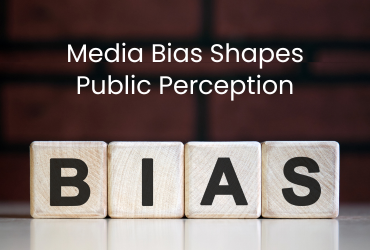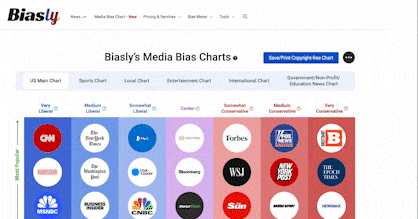
In an era flooded with information, knowing the difference between what is true and what is twisted has never been more crucial. We often hear about “fake news:” blatantly false stories designed to deceive. However, media bias is more difficult to spot.
While fake news is entirely false, media bias is often hidden: it misrepresents facts without making explicitly false statements. This subtlety makes it harder to detect as it erodes public trust and shapes opinions on skewed information.
In this article, we will explore five common types of media bias and examine recent real-life examples. We will also delve into how media bias impacts major societal events (such as the COVID-19 vaccine rollout) and investigate social media’s role in amplifying media bias. Finally, we will discuss how the public can identify media bias and find the most trustworthy and least biased sources.
Types of Media Bias
Media bias comes in many different forms, but let’s look at five common types:
- Negativity Bias
- Sensationalism
- Framing Bias
- Omission Bias
- Selection Bias
Negativity bias is a self-explanatory phenomenon built into psychology; bad news tends to stand out to us. News organizations, driven by the need for clicks and views, lean into this tendency. This bias prioritizes negative details and storylines to draw attention.
Secondly, sensationalism is also used to grab the audience’s attention. It exaggerates stories with emotionally charged language and visuals.
Next, the framing bias is when a story’s context or wording influences how it is perceived. It steers readers to a particular interpretation. For example, an article might describe “protestors” as “rioters,” a word that carries an unfavorable connotation.
Omission bias is even more subtle. It’s what the story intentionally leaves out. An article might share a terrifying video clip and label it as a threat without revealing that the incident was actually isolated (omission bias in action!). An article might also share a study’s findings without noting its constraints and limitations.
Finally, selection bias determines which stories get covered in the first place. Different organizations may report varying accounts and selectively choose which ones to highlight, thereby favoring a specific narrative.
A Recent Example
To see these biases in action, consider the recent U.S. strikes on Iranian nuclear facilities in June 2025. The same event, covered by two major networks, CNN and Fox News, yielded two dramatically different interpretations.
CNN’s article was titled, “Early US intel assessment suggests strikes on Iran did not destroy nuclear sites, sources say.” It shared how U.S. military strikes did not destroy Iran’s nuclear facilities. The article then states that the Defense Intelligence Agency had not previously reported this assessment and cites “one of the sources” (without providing an official name).
Later on, CNN reported President Trump’s belief that the strikes obliterated Iran’s nuclear facilities. However, it shared that it is too early to tell the actual severity of the strikes.
These differences in reporting raise skepticism about the dramatic headline and the article’s details. Suppose it is too early to understand the damages, and there are conflicting sources, then why say firmly that “US military strikes on three of Iran’s nuclear facilities last weekend did not destroy the core components of the country’s nuclear program”?
On the flip side, Fox News’ headline stated, “Expert confident Iran’s nuclear program is ‘no longer’ after massive US strike.” It shares how Jonathan Schanzer, Executive Director of the Foundation for Defense of Democracies, states that “The nuclear program is no longer” (Fox News, 2025). The article also cites President Trump saying that Iran’s key facilities have been completely obliterated and shows pictures of the destroyed locations.
There is no surprise that CNN is a left-leaning organization and Fox News is a right-leaning one. It is interesting how each of these outlets portrays the same incident in different ways. They take quotes from different groups, those that support the narratives they wish to portray.
When these sources are placed side by side, it is confusing and challenging to determine which article shares the truth!
This example clearly illustrates how media bias can distort public understanding. But such distortions aren’t limited to isolated events.
When Bias Spreads Worldwide
The stakes become even higher when media bias intersects with prominent world events.
During the COVID-19 pandemic, the COVID-19 vaccines were publicized worldwide. Many news outlets and social media users fell into predictable bias traps. According to the American Journal of Managed Care, headlines often emphasized the necessity of such vaccines, highlighting their vital role in saving lives. However, conflicting news reports were abundant. Organizations swore that these vaccines were necessary for those with specific health issues, while others claimed these vaccines negatively affected people with those same health issues.
Headlines focused on either positive sensationalist headlines like “COVID-19 vaccinations have saved over 14 million lives” or negative ones like “heart inflammation” and “vaccine deaths.”
Furthermore, the media’s tendency to omit information regarding the vaccine provided more confusion and distorted articles. Organizations weren’t sharing the exact ingredients of the vaccine. Plus, possible long-term side effects were being downplayed as unimportant, when in reality, no one knew what the long-term effects would be. The government and the American Heart Association also pushed for faster and mandatory vaccine requirements before the vaccines were even approved by the FDA (AJMC, 2021). Additionally, with a lack of information about the vaccine and a lack of FDA approval, concerns were present, and differing information was being spread online.
The psychological impact of bias is well-documented. A 2022 study by Lindgren and Lindholm found that negatively framed statistics are perceived as more trustworthy than their positively framed counterparts, even when the two convey the same information. For instance, people are more likely to trust a statement saying “5% experienced side effects” than one saying “95% experienced no side effects.”
Overall, numerous news articles and social media posts described the COVID-19 vaccines in conflicting ways. Bias existed on both sides of the vaccine debate, resulting in more confusion than clarity. Unfortunately, media bias has existed independently of global pandemics forever. Elections (and any political happening) breed media bias, but that was too big a topic to cover.
These examples illustrate how media bias can influence public opinion on critical issues. Yet, traditional media is no longer the only, or even the primary, source of information for many people.
Social Media: The Bias Multiplier
There is no denying that social media is everywhere. Social media algorithms favor content that generates engagement, so it is no surprise that they use outrage, fear, and validation to achieve that.
This creates “echo chambers,” where users are shown more content that aligns with their existing views, reinforcing their beliefs and making alternative perspectives seem wrong or dangerous. Within these bubbles, selection bias flourishes: people are drawn to information that confirms their existing beliefs and overlook information that challenges them.
The same Lindgren study also noted that perceptions of truth are influenced not just by framing but by trust in the source. A CNN viewer may scoff at a Fox headline at first sight, while a Fox viewer may dismiss a CNN analysis.
Additionally, social media spreads biased stories faster than traditional news ever could. Someone might see a biased post without realizing it’s biased, then continue to share the post among their social media accounts. This pattern quickly snowballs.
Even when bias is unintentional, its reach and impact can be vast and largely invisible to those immersed in it.
Fighting Back Against Bias
So, how can we find accurate, objective information and not fall into bias traps?
Fact-checking tools are lifesavers. Biasly, in particular, provides real-time bias ratings, showing how news is framed across ideological lines and ultimately helping users find balance.
For example, the Media Bias Chart and the Media Bias Ratings List both help inform audiences. The Media Bias Chart ranks news sources across the political spectrum. It reveals a news organization’s political stance, allowing you to recognize potential implicit biases when reading articles.
The Media Bias Ratings List delves even further into detail by rating articles themselves. By analyzing types of bias—including slant, tone, and source usage—Biasly enables users to break out of echo chambers and explore unbiased news sources. From identifying subtle political slants to distinguishing between biased media and unbiased news sources, their ratings give you the tools to navigate today’s complex news media landscape with greater confidence and understanding.
Furthermore, media literacy education is another way we can become more aware of bias. By learning about the different types of bias and keeping our eyes peeled for them, we can identify when biases are being used.
And of course, each of us has a role to play. Unfortunately, there will always be bias. No matter how much we know about media bias and how it’s shared, we are human beings. Human beings are subject to implicit biases – we should all check our own biases as well.
It is important to read beyond the headlines and seek out different perspectives. We should also keep an open mind and calm our emotions before sharing an instigative post. That way, we too, can help limit biases in ourselves and online.


























